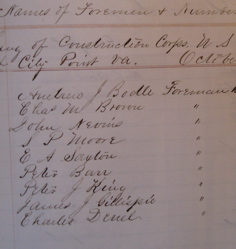Railroad Workers and Railroad Work
Related Documents
- An Army of Clerks
- A Freight Crew and Its Hack
- Contract for Negro Slaves, December 23, 1853
- Letter from Claudius Crozet to the Virginia Board of Public Works, December 28, 1854
- Railroad Workers, 1850s
- Payroll for M. O'Hara, Machinist, Knoxville, TN, August, 1865
- Payroll for C. H. Grenz, Blacksmith, Knoxville, TN, August, 1865
The most important study of railroad work is Walter Licht, Working for the Railroad: The Organization of Work in the Nineteenth Century (Princeton: Princeton University Press, 1983). Licht focused on the types and nature of railroad labor, company rules and the workplace, the supply of labor, discipline and longevity, social mobility, accidents and perils, and on creating a social profile of railroad laborers. He makes careful distinctions between the South and the North, and his focus is mainly on the 1840s, 50s, and 60s or what he calls the first generation of railroad workers. Licht notes that the 1880 census is the first to classify railroad employees, with 418,956 employees in the industry. In his detailed analysis of workers, Licht finds that there was considerable turnover--over 50 % of employees left the companies after 6 months and only 25 % stayed with a company on the payroll for two years. On the premier railroads the turnover In another interesting conclusion he argues that the greatest surge in railroad employment as a new classification of work took place in the 1850s when the work force on railroads essentially tripled.
Railroad work, despite the dangers, offered high rewards. Employees moved up relatively quickly and an "age hierarchy" on the lines made experience count for promotion. Large numbers of Irish immigrants worked on construction crews. Jobs on a company's operational payroll were more difficult to attain and keep. Railroad workers were dismissed in economic downturns, such as 1857, 1873, 1877, 1888, and 1893, as well as for rule violations, alchohol use, absenteeism, and other causes.
Licht's profile of railroad workers indicates that most were young men, white, and native born. Northern lines did not hire black workers as a rule. Licht cites the 1860 Philadelphia census where there was not a single black railroad worker listed in the city. Blacks were not hired on the Chicago, Burlington and Quincy or on the Illinois Central. In the South enslaved black workers built the roads and often worked on the operating crews of the railroads as firemen and brakemen.
Railroad work created a highly mobile set of opportunities and a highly diverse geography and occupational structure.
